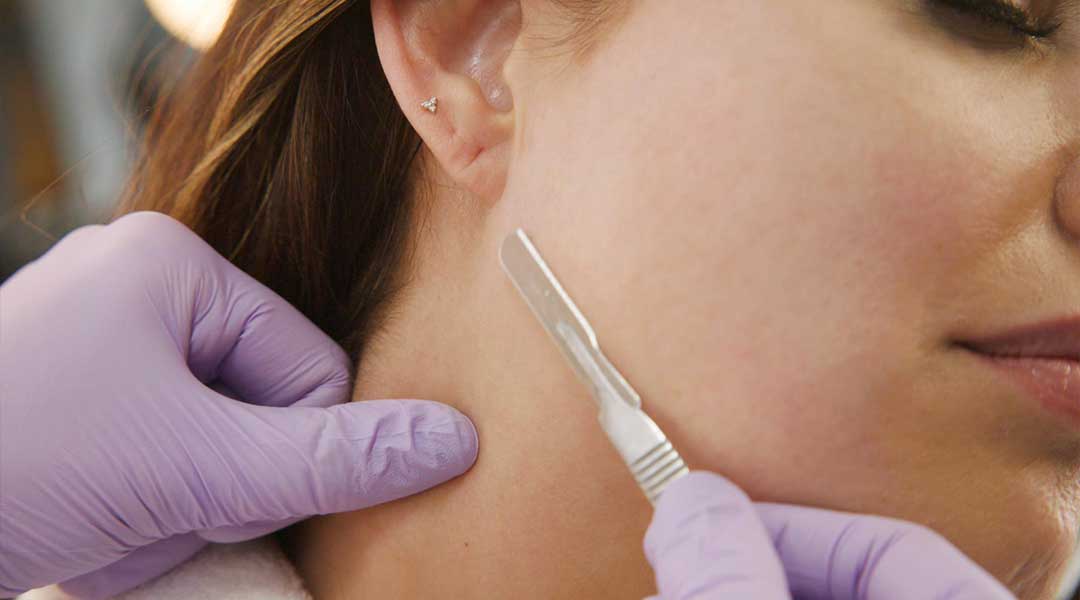Dermaplaning is a non-surgical method of removing debris and fine hairs that grow on the face. Using a specialised tool, the dermaplaning procedure is performed to essentially shave the fuzz, known as vellus hair, off the face and has become an increasingly common procedure over the past few years as more and more people opt to try it. In addition to removing vellus hair (or peach fuzz as some people call it), it can also remove the outer layers of dead skin cells which leaves the skin looking softer, smoother and cleaner. But what happens during a dermaplaning treatment and what benefits (and negatives) are associated with it?
We’ll start by taking a quick dive into what the treatment is and how it’s carried out. Dermaplaning is carried out using a tool that resembles a scalpel or razor and the process is very similar to shaving that you would normally carry out at home. By aiming the dermaplaning blade at a 45 degree angle and gently dragging it across the surface of the skin, you are able to remove dead skin cells, vellus hairs, scar tissue and other forms of debris that negatively impact the appearance of the skin.
Every day, your skin is exposed to a number of external influences such as the effects of weather, environmental toxins, irritants and even things like makeup which can cause the skin to appear dull and amplify the effects of ageing. The dermaplaning procedure is designed to clear this away by removing the damaged outer layers and allowing the new skin cells to come through, giving you a younger and more radiant appearance.
After the treatment has been completed, it’s common to have some form of soothing lotion such as aloe and will apply sunscreen to protect your skin. Following on from a dermaplaning procedure you need to be incredibly careful about sun exposure to your skin. The damage that the sun can cause can completely undo all the positives provided by the dermaplaning treatment or can cause pigment blotches on the new skin cells. It’s highly recommended to ensure you are wearing sunscreen to protect your face for the first few weeks after a dermaplaning treatment.

What about the risks and side effects of a dermaplaning treatment?
As with all procedures, there is some form of risk associated with dermaplaning treatments but, in general, it is considered to be a an incredibly low-risk procedure. The most common side effects include redness on the face (although this will fade very quickly) and the possible breakout of spots and whiteheads as the new skin is exposed to the elements for the first time.
Infection in the area and scarring are a possibility as well, although these are considered to be very rare side effects. If you do develop any form of scarring, speaking with your aesthetician immediately will help as they will be able to assist with this.
Another possibility is patchy skin pigment in the treated area, which can naturally decrease and disappear as time passes but it extreme cases may require an additional treatment to resolve.
What to expect with dermaplaning
The good news is that you won’t need to plan for any downtime following your treatment, provided that you follow the correct aftercare procedures. As we explained within the risks, you may experience some form of redness or a slight amount of pain within the skin but this will die down very quickly over the coming days.
Directly following the dermaplaning procedure, you’ll notice that your skin looks much brighter but this will continue to improve over the coming days, with full results showing through once the redness completely subsides. It’s important to note that the results that you receive will not be a permanent result and after a few weeks as the skin cells go through their lifecycle, the results will begin to fade and to maintain the look you will need to book in for a further treatment.
So what are the major pro’s and con’s then?
We’ll start with the pro’s;
- Dermaplaning is a form of painless exfoliation that removes the peach fuzz, dead skin and debris that cause the skin to look dull
- It’s perfect for people who suffer from sensitive skin or pregnant women
- It can be performed prior to a number of other facial treatments to improve the results that you receive
- It can be performed as often as you need to maintain the look it provides
- Following the procedure, makeup will be able to be applied much more smoothly and evenly
- Contrary to common belief about shaving, the hair will not grow back thicker or faster
And the con’s;
- The results aren’t generally as long lasting as other hair removal treatments as the hair is only shaved away
- Results are different for everyone and will last different lengths of time, depending on the hair-growth cycle of the individual client
- Not everyone will be a perfect candidate, although most are, and those who suffer with acne may be advised against undergoing a dermaplaning treatment as it can cause further irritation
All in all, dermaplaning treatments are an incredible way to improve the appearance of the skin by removing external debris that causes it to look dull, leaving you with a much brighter glow, with very little risk associated with it. To find out more about this incredible treatment and how it could benefit you, click here.

